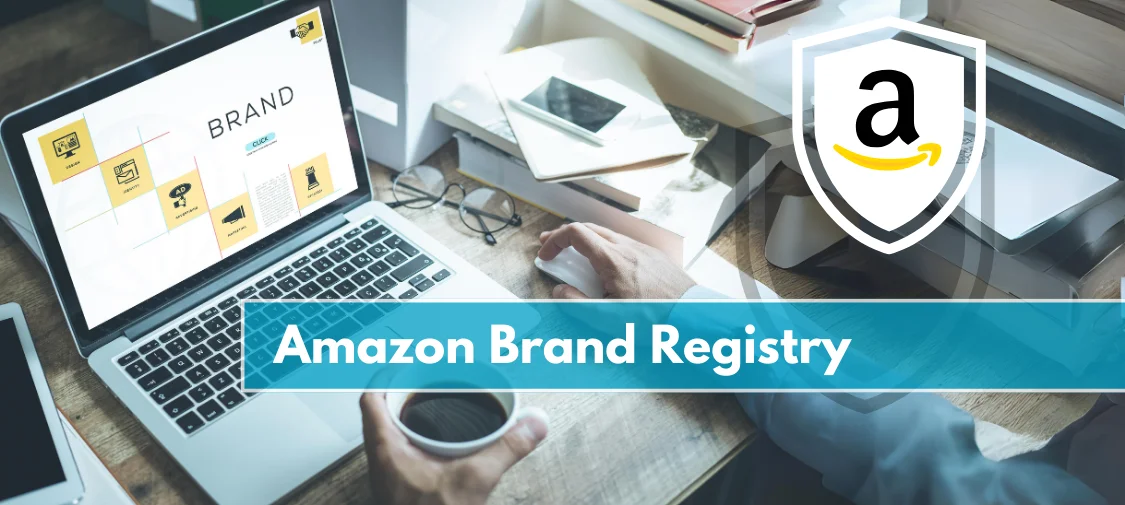Amazon
How to Liquidate Amazon Inventory: 8 Proven Ways
Every Amazon seller eventually encounters the same problem: excess inventory sitting in FBA warehouses. It may happen because of seasonal demand drops, forecasting errors, product defects, or shifting consumer trends. Whatever the reason, unsold stock locks up capital, drags down your Inventory Performance Index (IPI), and racks up storage fees.
Liquidation isn’t a mark of failure. It’s a tool that smart sellers use to recover cash, free up storage, and protect long-term margins. In this guide, we’ll explore eight proven liquidation methods, outlining how each works, what you can expect, and the pros and cons of choosing one approach over another. Think of this as your playbook for clearing inventory strategically rather than desperately.
8 Proven Ways for Amazon Inventory Liquidation
Following are the 8 proven ways for Amazon inventory liquidation:
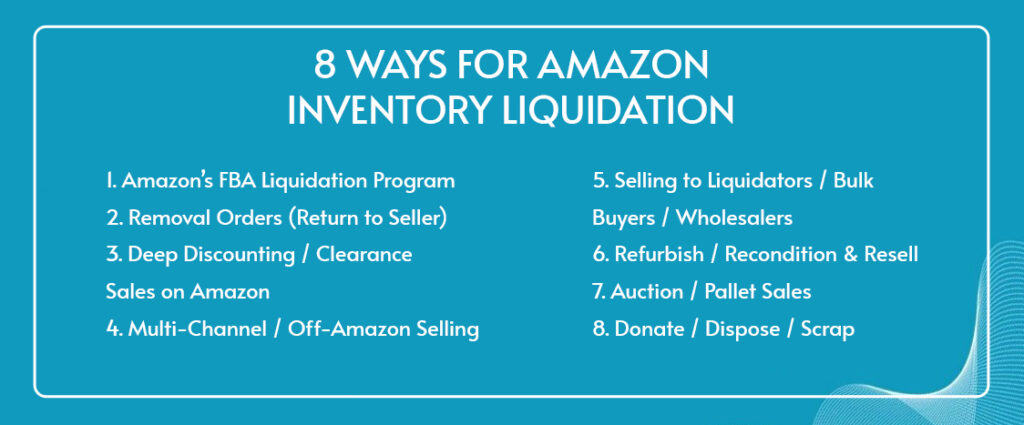
1. Amazon’s FBA Liquidation Program
Amazon’s in-house liquidation program connects your unsold inventory with contracted liquidators. You submit qualifying SKUs, Amazon handles the logistics, and you receive a small payout after fees. Eligibility varies: some categories, hazardous items, or expired goods won’t qualify.
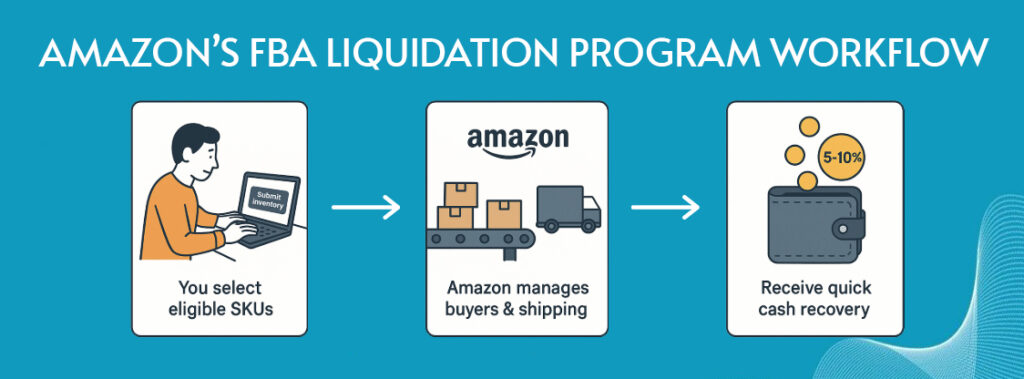
Typically, sellers recover between 5–10% of the retail value after deductions. While this may seem low, the convenience and speed often outweigh other considerations. You won’t need to negotiate with buyers or manage shipments yourself, making it an almost effortless option.
Pros
- Minimal effort, Amazon handles everything
- Clears stock quickly
- Improves IPI by reducing aged inventory
Cons
- Low recovery value
- No control over resale channels
2. Removal Orders (Return to Seller)
Removal orders let you recall inventory from FBA back to your own address, prep center, or warehouse. Unlike liquidation, where you lose control, removal gives you flexibility: you can resell, refurbish, bundle, or liquidate through other channels later.
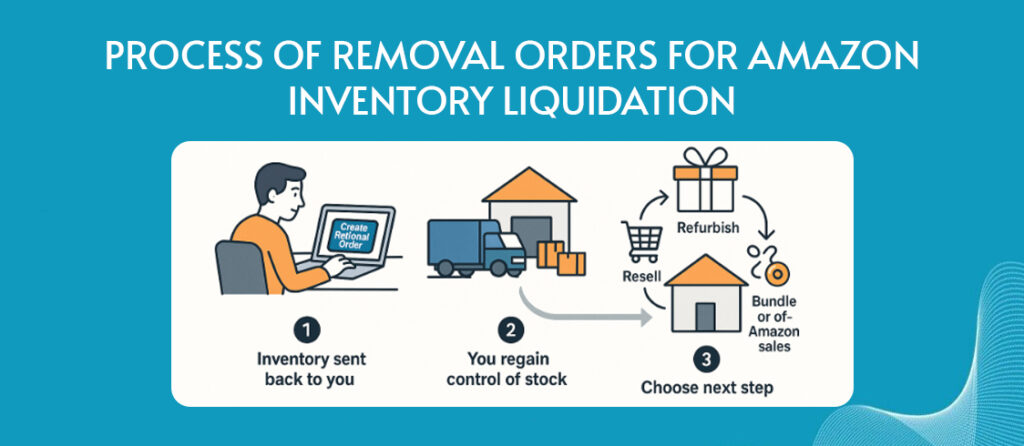
The downside is cost. You’ll pay per-unit removal fees plus shipping, and there’s a risk of goods being damaged in transit. Still, this path makes sense for higher-value products that can be resold at better margins elsewhere. Many sellers pair removal with off-Amazon sales or refurbished listings to recover more value than Amazon’s liquidation program would offer.
Pros
- Full control once inventory is back
- Potentially higher recovery through resale
- Flexible path (resell, refurbish, rebrand)
Cons
- Removal and shipping fees add up
- Risk of damaged goods in transit
3. Deep Discounting / Clearance Sales on Amazon
One of the fastest ways to move stock is to discount heavily within Amazon itself. Options include Lightning Deals, 7-Day Deals, and coupon campaigns. Sellers can also use Amazon Outlet, which provides a structured way to market clearance inventory directly to deal-seeking shoppers.
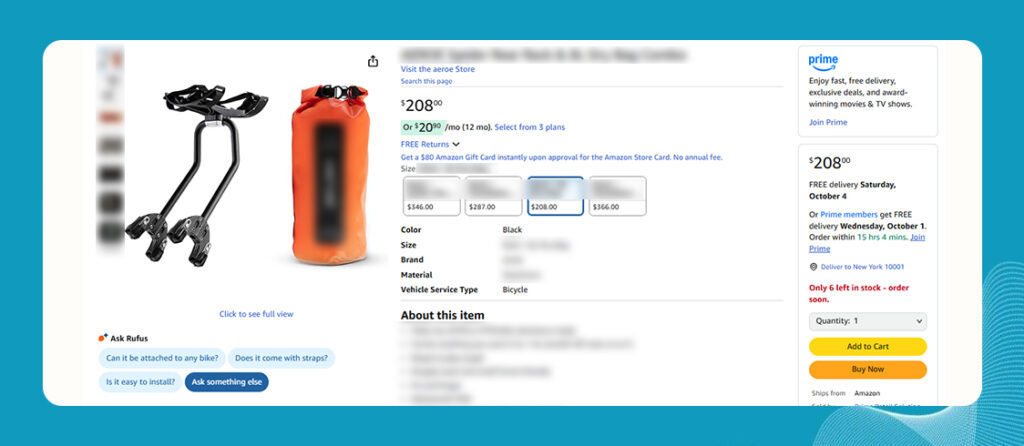
Another tactic is bundling. Pairing slow movers with popular SKUs in combo packs increases sell-through and clears lagging inventory without simply slashing prices. While this approach often yields higher recovery than liquidation, it does come at the expense of margins and can train customers to expect discounts.
Pros
- Higher recovery potential than liquidation
- Maintains Amazon sales velocity and ranking signals
- Options like bundles add creative flexibility
Cons
- Significant margin erosion
- Can devalue brand if used repeatedly
4. Multi-Channel / Off-Amazon Selling
Excess inventory doesn’t have to die on Amazon. Many sellers redirect stock to eBay, Walmart Marketplace, Shopify, or niche platforms. If the goods remain in FBA, you can even use Amazon’s Multi-Channel Fulfillment (MCF) service to fulfill orders outside Amazon.

This route broadens your audience and may yield better margins, especially if you already have DTC infrastructure. The challenge is operational: you’ll need to manage listings, fulfillment, and customer service. Still, for brands building multi-channel strategies, this is an effective way to squeeze value from slow Amazon stock.
Pros
- Broader audience, potentially better recovery
- Keeps brand control outside Amazon
- Fits into long-term multi-channel strategy
Cons
- More operational overhead
- Higher fulfillment and service complexity
5. Selling to Liquidators / Bulk Buyers / Wholesalers
Another route is to sell directly to bulk buyers outside Amazon’s system. This could mean liquidators, wholesalers, or discount retailers who purchase pallets or truckloads. The process is simple: create a manifest, negotiate terms, and ship.

Recovery is usually low as sometimes just pennies on the dollar, but you gain speed and volume clearance. For sellers with thousands of units that must be moved quickly, this is often the most realistic path.
Pros
- Quick solution for large volumes
- Minimal ongoing work
- Offloads inventory in one transaction
Cons
- Very low recovery value
- No control over end-market or resale
6. Refurbish / Recondition & Resell
Returned, slightly damaged, or open-box products may still have value if refurbished. This can mean cleaning, repackaging, or repairing goods so they qualify for resale either on Amazon (if category rules allow) or off-platform.
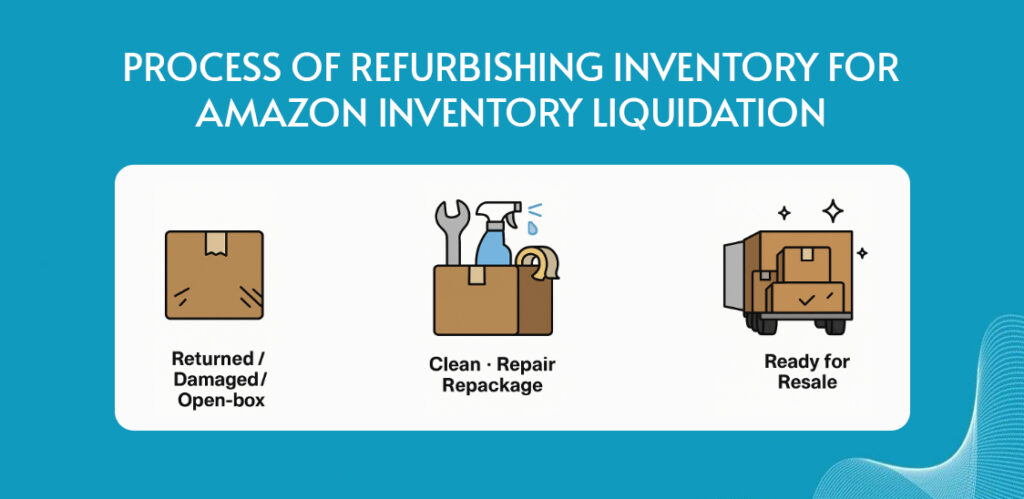
The key question is cost. You must weigh the expense of labor, materials, and compliance against the resale value. For certain high-value categories like electronics or appliances, refurbishment can make sense. For low-margin consumables, it rarely does.
Pros
- Recovers value from otherwise unsellable stock
- Works well for durable, higher-value goods
- Keeps products out of landfills
Cons
- Labor and compliance costs are high
- Not all categories allow refurbished resale
7. Auction / Pallet Sales
Auctioning inventory in pallets or lots is another bulk-clearance method. Sellers can list lots on platforms like B-Stock, Liquidation.com, or even local auction houses. Buyers expect low pricing, so per-unit recovery is modest, but this moves large quantities at once.

Transparency is key. Providing manifests and grouping items logically reduces buyer risk and improves clearance speed. While recovery won’t match resale or discounting, it’s often a middle ground between Amazon liquidation and direct bulk buyers.
Pros
- Moves large quantities in one go
- Faster than piecemeal sales
- Buyers assume clearance pricing, minimizing negotiation
Cons
- Low per-unit recovery
- Limited control once stock is sold
8. Donate / Dispose / Scrap
When nothing else makes sense, donation or disposal may be the cleanest exit. Amazon offers disposal services, and in some regions, donation options that send products to charities.
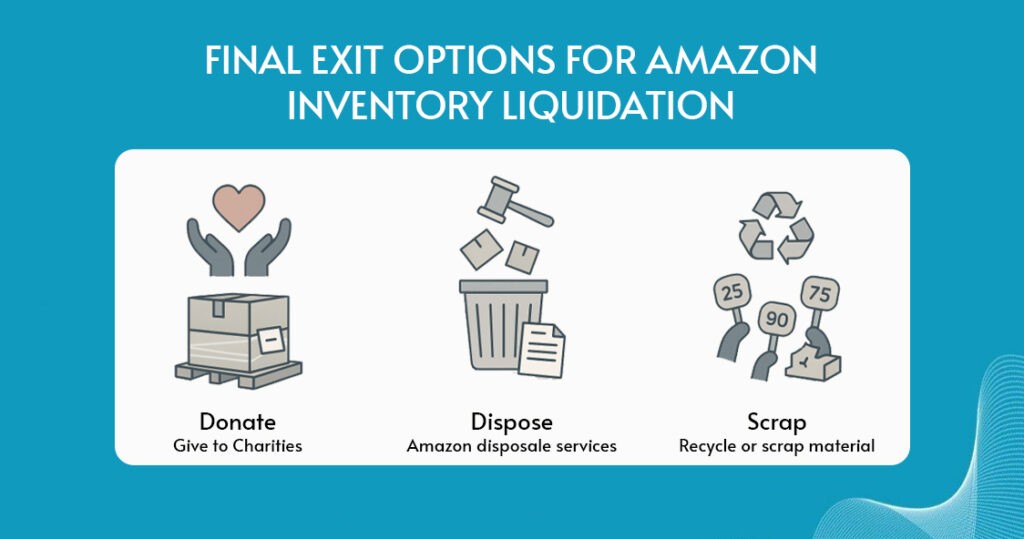
Financially, recovery is zero, though donations may provide tax benefits depending on your jurisdiction. This method is best reserved for expired, obsolete, or unsellable goods where holding or shipping costs outweigh any potential revenue.
Pros
- Clears inventory instantly
- Potential goodwill or tax benefits from donation
- Simple and low-effort
Cons
- No financial recovery (beyond tax write-offs)
- Total loss absorbed by seller
Comparison & Decision Guidance
Each method balances speed, effort, yield, and control differently. FBA liquidation is nearly effortless but offers the lowest recovery. Removal orders, discounting, and multi-channel resale require more involvement but can deliver higher returns. Refurbishment, pallet sales, and direct bulk deals sit in the middle, offering mixed recovery and control. Donation and disposal remain the final fallback for truly unsellable stock.
A simple rule of thumb:
1. If speed is the priority, use Amazon liquidation, pallet sales, or bulk buyers.
2. If maximizing recovery matters, choose discounting, multi-channel sales, or refurbishment.
3. If goods are unsellable, donate or dispose.
Conclusion
Liquidation is not failure, it’s resource management. By clearing out excess or dead stock, you recover capital, protect account health, and make room for profitable inventory.
The eight methods available: Amazon liquidation, removal orders, discounting, multi-channel sales, third-party buyers, refurbishment, pallet auctions, and donation or disposal, each offer unique trade-offs.
Your next move is simple: run an aged inventory audit, match SKUs to the right liquidation method, and act decisively. Done strategically, liquidation limits losses today and positions your business for healthier growth tomorrow.
However, if managing your inventory on Amazon seems a task to you, you can outsource it to a reliable 3P partner. Prime Retail Solution is one of them, managing inventories and scaling the businesses of brands for years. So, book a free consultation call right now and discuss the profitability of your business.
FAQ
Q1: What percent will I typically recover?
Between 5–10% for Amazon liquidation, up to 50% or more with discounting or off-Amazon resale.
Q2: Can I cancel a liquidation order once started?
Generally no. Once inventory is sent to liquidators, the process is final.
Q3: Are all SKUs eligible for liquidation?
No, categories like hazmat or restricted goods are excluded.
Q4: Does liquidation improve my IPI?
Yes. Clearing aged or excess stock helps IPI performance.
Q5: Which method should I try first?
Start with a value-based audit: high-value salvageable items should go to resale or refurbishment, while low-value bulk goods are better suited for liquidation or pallet sales.
Share



